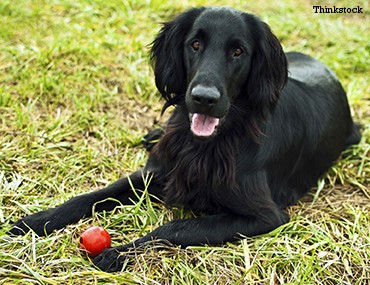Background
Retrievers were bred by fisherman who needed water loving dogs to retrieve fowl after it had been shot. They were especially popular in the fisheries near Newfoundland. In fact the Newfoundland breed played an important part in retriever bloodlines along with setters, sheepdogs, and water spaniels. Flat-Coated Retrievers, which weren't always called that, were popular show dogs soon after they were introduced. But their coats were not always flat; Sewallis E. Shirley, founder of Britain’s Kennel Club, was largely responsible for the appearance they have today. It was thought that a flat coat might be more water repellent.
Flat-Coated Retrievers were recognized by the American Kennel Club in 1915 but their popularity didn’t last much beyond that. They were eclipsed by both Golden Retrievers and Labradors. By the end of World War II Flat-Coated Retrievers were facing extinction. Breed loyalist managed to save them and today the breed enjoys a modest popularity.
Sizing up
- Weight: 60 to 70 lbs.
- Height: 22 to 24.5 inches
- Coat: Straight, medium length
- Color: Solid black, liver-colored.
- Life expectancy: 10 to 13 years
What’s the Flat-Coated retriever like?
The Flat-Coated is the most energetic of the retrievers. What that means for you is that she needs plenty of exercise every single day of the week. Rain or shine the Flat-coated wants to run, jump, chase, fetch, play, and dig. You won’t be able to get away with only bringing her outside to go to the bathroom. She also doesn’t like to be left alone and if you’re not with her she won’t have any fun at all. When you’re spending time outside you should know that the Flat-Coated will chase after birds, squirrels and other small animals. She’ll also be very interested in meeting new people who happen to be walking by.
The Flat-Coated retriever is definitely a food dog, which you can use to your advantage during training, e.g., hide a treat underneath one of three boxes and let her sniff it out. The Flat-Coated will take to training well.
Indoors the Flat-Coated Retriever should be well behaved, assuming she’s had enough exercise. She’s friendly with kids but could easily overwhelm younger children. She’ll want to be in contact with her people: ideally curled up at your feet or next to you on the couch. She might bark at intruders but won’t show them any aggression.
The Flat Coated is always happy when people are around. She’s not particularly picky about which people they are either. She is sometimes referred to as the “peter-pan” dog in reference to her extended puppyhood. She’ll always be a source of entertainment and laughter for the family.
Health
Flat-Coated dogs have a higher incidence of cancer than other breeds: Hemangiosarcoma, fibrosarcoma, osteosarcoma and malignant histocytosis are all possible. Other conditions to watch for include the following:
Takeaway Points
- Flat-Coated Retrievers are the most energetic of the retrievers.
- Flat-Coated Retrievers don’t like to be left alone.
- Flat-Coated Retrievers will love anyone who gives them food.
- Flat-Coated Retrievers remain immature for most of their lives.
If you have any questions or concerns, you should always visit or call your veterinarian -- they are your best resource to ensure the health and well-being of your pets.
